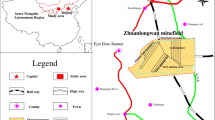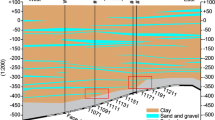Abstract
Disastrous surface water incursions can easily occur during mining in the loess area of western China because of the shallow depth and great thickness of the coal seams there. Effective water control and drainage measures are essential to prevent such disasters. Using panels 90102 and 90103 of the Antaibao Mine of the Pingshuo mining area, Shanxi Province, as a case study, we analyzed the causes of the problem and the risk of surface water infiltration. Based on the vertical zoning features of the predicted deformation of the overburden strata and ground movement, the water-conductive fracture zone was 149.7 m thick, which means that mining could induce the inrush of surface water into the mining areas. A comprehensive set of methods was proposed, including excavation of drainage ditches, backfilling of subsiding areas, and construction of underground drainage channels. While these modifications were made in response to the geological and topographical conditions and surface drainage patterns of this site, similar methods can be used for other mines in loess areas.
抽象
中国西部黄土区的浅埋厚煤层矿区易发生灾害性地表水突水,有效水害防制和疏水技术措施对此类水害防治致关重要。以山西平朔安太堡矿90102和90103盘区为例,分析了潜在地表水害形成原因和地表水入渗风险。基于顶板覆岩变形和岩层运动特征,预测导水裂隙带高度为149.7m,煤层回采可能诱发地表水突水。为此,提出包括开挖排水沟、回填塌陷区、完善井下排水系统等防治措施。防治措施因地质和地貌特征而有所不同,该防治水技术亦可应用于黄土区其它煤矿。
Zusammenfassung
Im Zuge des Bergbaus in der Lössregion Westchinas können sich schnell verheerende Wassereinbrüche ereignen, da die dortigen Kohleflöze in geringer Tiefe mit großer Mächtigkeit anstehen. Eine effektive Wasser-haltung und Entwässerungsmaßnahmen sind unumgänglich, um derartige Havarien zu vermeiden. Mit der Fallstudie der Abbaufelder 90102 und 90103 der Antaibao-Mine im Bergbaugebiet von Pingshuo, Provinz Shanxi, untersuchten wir die Ursachen für das Problem und das Risiko des Eindringens von Oberflächenwasser. Gestützt auf vertikale Zonenmerkmale aus der prognostizierten Verformung der Deckschichten und der Bodenbewegung wurde eine wasserleitende Bruchzone von 149,7 m Mächtigkeit abgeleitet. Dies bedeutet, dass der Bergbau einen Einbruch von Oberflächenwasser in die Abbaufelder auslösen kann. Es wurde ein umfassendes Maßnahmenbündel vorgeschlagen, darunter der Aushub von Entwässerungsgräben, das Wiederauffüllen von abgesunkenem Gelände, sowie der Bau unterirdischer Entwässerungskanäle. Während diese technischen Anpassungen als Reaktion auf die geologischen und topo¬graphischen Bedingungen und das Muster der Oberflächenentwässerung in diesem Gebiet erfolgten, können ähnliche Maßnahmen bei anderen Bergwerken in Lössgebieten zur Anwendung kommen.
Resumen
En la minería de la zona de loees de China occidental pueden ocurrir desastres por irrupciones de agua de superficie debido a la poca profundidad y gran espesor de las vetas de carbón en esa zona. Un efectivo control de agua y medidas de drenaje son esencial para prevenir tales desastres. Usando los paneles 90102 y 90103 de la mina Antaibao del área minera de Pingshuo, provincia de Shanxi, como un caso de estudio, hemos analizado las causas del problema y el riesgo de infiltración de agua de superficie. Basándose en las características de zonificación vertical de la deformación pronosticada de los estratos de sobrecarga y el movimiento del suelo, se predijo una zona de fractura conductora de agua de 149,7 m de espesor indicando que la minería podría provocar la irrupción de agua de superficie en las áreas de trabajo. Se propuso un conjunto de métodos incluyendo la excavación of zanjas de drenaje, relleno de áreas circundantes y construcción de canales subterráneosde drenaje. Si bien estas modificaciones se hicieron en respuesta a las condiciones geológicas y topográficas y patrones de drenaje superficial de este sitio, métodos similares pueden ser utilizados para otras minas en áreas de loess.










Similar content being viewed by others
References
Akbarzadeh H, Chalaturnyk RJ (2014) Sequentially coupled flow-geomechanical modeling of underground coal gasification for a three-dimensional problem. Mitig Adapt Strateg Glob Change 21:577–594
Bai YJ (2009) Causes analysis and control technology of water disaster in coal mines. Coal Technol 28:85–87 (in Chinese)
Chen JJ, Chen Y, Guo WB, Zou YF (2013a) Study on surface movement law under the condition of thick unconsolidated strata. Coal Sci Technol 41:95–102 (in Chinese)
Chen LW, Zhang SL, Gui HR (2013b) Prevention of water and quicksand inrush during extracting contiguous coal seams under the lowermost aquifer in the unconsolidated Cenozoic alluvium—a case study. Arab J Geosci 7:2139–2149
Chen LW, Feng XQ, Xie WP, Xu DQ (2016) Prediction of water-inrush risk areas in process of mining under the unconsolidated and confined aquifer: a case study from the Qidong coal mine in China. Environ Earth Sci 75:706
Aguado MBD, Nicieza CG (2007) Control and prevention of gas outbursts in coal mines, Riosa–Olloniego coalfield, Spain. Int J Coal Geol 69:253–266
Dong SN, Hu WY (2007) Basic characteristics and main controlling factors of coal mine water hazard in China. Coal Geol Explor 35:34–37 (in Chinese)
Dong DL, Sun WJ, Sha X (2012) Optimization of mine drainage capacity using FEFLOW for the No. 14 coal seam of China’s Linnancang coal mine. Mine Water Environ 31:353–360
Fang J, Xu HJ, Cap ZG, Li P (2016) Calculation on height of water conducted zone for fully-mechanized top coal caving mining in thick seam under soft and weak overburden strata. Coal Sci Technol 44:67–73 (in Chinese)
He KQ, Yu WC, Jiang WF (2011) Analysis of groundwater inrush conditions and critical inspection parameters at the Baixiangshan iron mine, China. Mine Water Environ 30:274–283
Hu WY, Tian G (2010) Mine water disaster type and prevention and control countermeasures in China. Coal Sci Technol 138:92–96 (in Chinese)
Kang YS, Liu QS, Gong GQ, Wang HC (2014) Application of a combined support system to the weak floor reinforcement in deep underground coal mine. Int J Rock Mech Min 71:143–150
Krzysztof P, Kazmierz R, Piotr C (2016) Causes and effects of uncontrolled water inrush into a decommissioned mine shaft. Mine Water Environ 35:128–135
Li PX, Tan ZX, Yan LL, Deng KZ (2010) Calculation method of probability integration method parameters based on support vector machine. J China Coal Soc 35:1247–1251 (in Chinese)
Li LP, Zhou ZQ, Li SC, Xue YG, Xu ZH, Shi SS (2014) An attribute synthetic evaluation system for risk assessment of floor water inrush in coal mines. Mine Water Environ 34:288–294
Shu ZY, Li L, Li HJ (2016) Study on conducted zone and caving zone height of overlying rock with extremely thick coal in fully-mechanized caving coal face. Coal Sci Technol 44:53–54 (in Chinese)
Sun WJ, Wu Q, Dong DL, Jiao J (2012) Avoiding coal–water conflicts during the development of China’s large coal-producing regions. Mine Water Environ 31:74–78
Sun XQ, Jiang ZQ, Wang ZS, Li YJ (2015a) Height prediction of the “two zones” in shallow coal seam by slicing mining. Min R D 35:69–72 (in Chinese)
Sun WJ, Zhou WF, Jiao J (2015b) Hydrogeological classification and water inrush accidents in China’s coal mines. Mine Water Environ 35:214–220
Wang YL, Jia WY (2003) Analysis and application of two zone height in deep seam mining. Coal Sci Technol 31:31–38 (in Chinese)
Wang ZJ, Huang ZG, Yao JX, Ma XL (2014) Characteristics and Main progress of the stratigraphic chart of China and directions. Acta Geol Sin 35:271–276 (in Chinese)
Wu Q, Wang MY (2006) Characterization of water bursting and discharge into underground mines with multilayered groundwater flow systems in the North China coal basin. Hydrogeol J 14:882–893
Wu X, Yu QC, Wang XG, Duan QW, Li XQ, Yang J, Bao YF (2006) Exploitation of coal resources under a surface water body. Chin J Rock Mech Eng 25:1029–1036 (in Chinese)
Wu X, Wang XG, Duan QW, Sun YD, Jia ZX, Li XQ (2007) Study on coal mining in seam under large reservoir areas. J China Coal Soc 32:1273–1276 (in Chinese)
Wu Q, Liu YZ, Yang L (2011) Using the Vulnerable index method to assess the likelihood of a water inrush through the floor of a multi-seam coal mine in China. Mine Water Environ 30:54–60
Wu Q, Cui FP, Zhao SQ, Liu SQ, Zeng YF, Gu YW (2013) Type classification and main characteristics of mine water disasters. J China Coal Soc 38:561–565 (in Chinese)
Wu Q, Fan ZL, Zhang ZW, Zhou WF (2014a) Evaluation and zoning of groundwater hazards in Pingshuo No. 1 underground coal mine, Shanxi Province, China. Hydrogeol J 22:1693–1705
Wu Q, Liu YZ, Zhou WF, Li BY, Zhao B, Liu SQ, Sun WJ, Zeng YF (2014b) Evaluation of water inrush vulnerability from aquifers overlying coal seams in the Menkeqing coal mine, China. Mine Water Environ 34:258–269
Wu Q, Liu YZ, Luo LH, Liu SQ, Sun WJ, Zeng YF (2015) Quantitative evaluation and prediction of water inrush vulnerability from aquifers overlying coal seams in Donghuantuo coal mine, China. Environ Earth Sci 74:1429–1437
Wu Q, Liu YZ, Wu XL, Liu SQ, Sun WJ, Zeng YF (2016a) Assessment of groundwater inrush from underlying aquifers in Tunbai coal mine, Shanxi province, China. Environ Earth Sci 75:737
Wu Q, Li B, Chen YL (2016b) Vulnerability assessment of groundwater inrush from underlying aquifers based on variable weight model and its application. Water Resour Manag 30:3331–3345
Xu YC, Li JC, Liu SQ, Zhou L (2011) Caculation on formula of “two zone” height of over lying strata and its adaptability analysis. Coal Min Technol 16:4–11 (in Chinese)
Yang JL, Teng YH (2009) Study on development law of water conducted fracture zone in top coal of fully mechanized top coal caving mining face. Coal Sci Technol 37:100–102 (in Chinese)
Yao Q, Tao F, Li SL, Li SL, Ning QY (2012) The subsidence prediction of coal mine “three under” mining based on probability integral method. Saf Coal Min 43:188–193 (in Chinese)
Zhang JC (2005) Investigations of water inrushes from aquifers under coal seams. Int J Rock Mech Min 42:350–360
Zhang JC, Peng SP (2005) Water inrush and environmental impact of shallow seam mining. Environ Geol 48:1068–1076
Zhang JC, Shen BH (2004) Coal mining under aquifers in China: a case study. Int J Rock Mech Min 41:629–639
Zhang ZL, Gao YF, Wu Q, Wei SM (2013) Discussion on the technical system of solid prevention and control on mining flooding. J China Coal Soc 38:378–383 (in Chinese)
Zhang JC, Sun Q, Zhou N, Jiang HQ, Germain D, Abro S (2016) Research and application of roadway backfill coal mining technology in western coal mining area. Arab J Geosci 9:558
Zhao K, Xu NX, Mei G, Tian H (2016) Predicting the distribution of ground fissures and water-conducted fissures induced by coal mining: a case study. Springerplus 5:977
Zhu G, Wu X, Li PH, Qi RJ, Mu WP, Fu RZ (2014) Coalmine surface water prevention and drainage in loess area. J China Coal Soc 39:1354–1360 (in Chinese)
Acknowledgements
The research was supported by the National Natural Science Foundation of China (No. 41572227), the Fundamental Research Funds for the Central Universities (No. 2652015125) and a Project supported by the Ministry of Land and Resources of China (201511056-3).
Author information
Authors and Affiliations
Corresponding author
Rights and permissions
About this article
Cite this article
Zhu, G., Wu, X., Yu, S. et al. Surface Water Control for Mining Thick, Relatively Shallow Coal Seams in the Loess Area of Western China. Mine Water Environ 37, 442–455 (2018). https://doi.org/10.1007/s10230-018-0517-1
Received:
Accepted:
Published:
Issue Date:
DOI: https://doi.org/10.1007/s10230-018-0517-1




